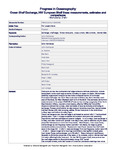Ocean Shelf Exchange, NW European Shelf Seas: measurements, estimates and comparisons
| dc.contributor.author | Huthnance, J | |
| dc.contributor.author | Hopkins, J | |
| dc.contributor.author | Berx, B | |
| dc.contributor.author | Dale, A | |
| dc.contributor.author | Holt, J | |
| dc.contributor.author | Hosegood, Philip | |
| dc.contributor.author | Inall, M | |
| dc.contributor.author | Jones, S | |
| dc.contributor.author | Loveday, B | |
| dc.contributor.author | Miller, P | |
| dc.contributor.author | Polton, J | |
| dc.contributor.author | Porter, M | |
| dc.contributor.author | Springys, C | |
| dc.date.accessioned | 2022-02-09T15:19:07Z | |
| dc.date.issued | 2022-03 | |
| dc.identifier.issn | 0079-6611 | |
| dc.identifier.issn | 1873-4472 | |
| dc.identifier.other | 102760 | |
| dc.identifier.uri | http://hdl.handle.net/10026.1/18734 | |
| dc.description.abstract |
Transports across the continental shelf edge enhance shelf-sea production, remove atmospheric carbon and imply an active boundary to ocean circulation. We estimate relatively large overall transport across three contrasted sectors of north-west European shelf edge: the Celtic Sea south-west of Britain, the Malin-Hebrides shelf west of Scotland, the West Shetland shelf north of Scotland. The estimates derive from measurements in the project FASTNEt (Fluxes across sloping topography of the North East Atlantic): drifters, moored current meters, effective “diffusivity” from drifter dispersion and salinity surveys, other estimates of velocity variance contributing to exchange. Process contributions include transport by along-slope flow, internal waves and their Stokes drift, tidal pumping, eddies, Ekman transports in the wind-driven surface layer and bottom boundary layer. Overall exchange across the shelf edge is estimated as several m2s−1: if extrapolated globally even 1 m2s−1 is large compared with oceanic transports and potentially important to shelf-sea and adjacent oceanic budgets. In our context, most exchange is in tides, and other motion with periods ∼ one day or less, and so effective only for water properties that evolve on such short time-scales. Nevertheless, cross-slope fluxes, and exchange by low-frequency motion (periods > two days), are large by global standards and also very variable. Deployment-mean fluxes nearest the shelf break were in the range 0.3–4 m2s−1; mean exchanges from low-frequency motion were 0.8–3 m2s−1. Deeper longer-term moorings and drifters crossing 500 m depth gave much larger fluxes and exchanges up to 20 m2s−1. These transports’ significance depends on distinctive properties of the water, or its contents, and on internal shelf-sea circulation affecting further transport. For the NW European shelf, transports across the shelf edge enable its disproportionately strong CO2 “pump”. The complex context, and small scales of numerous processes enabling cross-slope transports, imply a need for models. Measurements remain limited in extent and duration, but widely varied contexts, particular conditions, events, processes and behaviours are now available to support model validation, especially around the north-west European continental shelf edge. Variability still renders observations insufficient for stable estimates of transports and exchanges, especially if partitioned by sector and season; indeed, there may be significant inter-annual differences. Validated fine-resolution models give the best prospect of spatial and temporal coverage and of estimating present-day and potential future shelf-sea sensitivities to the adjacent ocean. | |
| dc.format.extent | 102760-102760 | |
| dc.language | en | |
| dc.language.iso | en | |
| dc.publisher | Elsevier | |
| dc.subject | Exchange | |
| dc.subject | Shelf edge | |
| dc.subject | Ekman transports | |
| dc.subject | Slope current | |
| dc.subject | Tidal currents | |
| dc.subject | Internal tides | |
| dc.subject | NW Europe | |
| dc.subject | Celtic Sea | |
| dc.subject | Malin-Hebrides shelf | |
| dc.subject | West Shetland shelf | |
| dc.title | Ocean Shelf Exchange, NW European Shelf Seas: measurements, estimates and comparisons | |
| dc.type | journal-article | |
| dc.type | Journal Article | |
| plymouth.author-url | https://www.webofscience.com/api/gateway?GWVersion=2&SrcApp=PARTNER_APP&SrcAuth=LinksAMR&KeyUT=WOS:000780381000003&DestLinkType=FullRecord&DestApp=ALL_WOS&UsrCustomerID=11bb513d99f797142bcfeffcc58ea008 | |
| plymouth.volume | 202 | |
| plymouth.publication-status | Published | |
| plymouth.journal | Progress in Oceanography | |
| dc.identifier.doi | 10.1016/j.pocean.2022.102760 | |
| plymouth.organisational-group | /Plymouth | |
| plymouth.organisational-group | /Plymouth/Faculty of Science and Engineering | |
| plymouth.organisational-group | /Plymouth/Faculty of Science and Engineering/School of Biological and Marine Sciences | |
| plymouth.organisational-group | /Plymouth/PRIMaRE Publications | |
| plymouth.organisational-group | /Plymouth/REF 2021 Researchers by UoA | |
| plymouth.organisational-group | /Plymouth/REF 2021 Researchers by UoA/UoA07 Earth Systems and Environmental Sciences | |
| plymouth.organisational-group | /Plymouth/Research Groups | |
| plymouth.organisational-group | /Plymouth/Research Groups/Marine Institute | |
| plymouth.organisational-group | /Plymouth/Users by role | |
| plymouth.organisational-group | /Plymouth/Users by role/Academics | |
| plymouth.organisational-group | /Plymouth/Users by role/Researchers in ResearchFish submission | |
| dcterms.dateAccepted | 2022-02-08 | |
| dc.rights.embargodate | 2022-2-25 | |
| dc.identifier.eissn | 1873-4472 | |
| dc.rights.embargoperiod | Not known | |
| rioxxterms.versionofrecord | 10.1016/j.pocean.2022.102760 | |
| rioxxterms.licenseref.uri | http://www.rioxx.net/licenses/all-rights-reserved | |
| rioxxterms.licenseref.startdate | 2022-03 | |
| rioxxterms.type | Journal Article/Review | |
| plymouth.funder | FASTNEt - Fluxes Across the Sloping Topography of the North East Atlantic::NERC |


